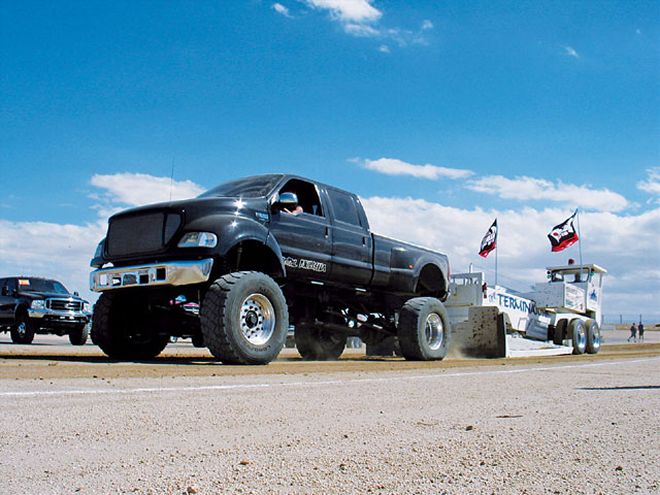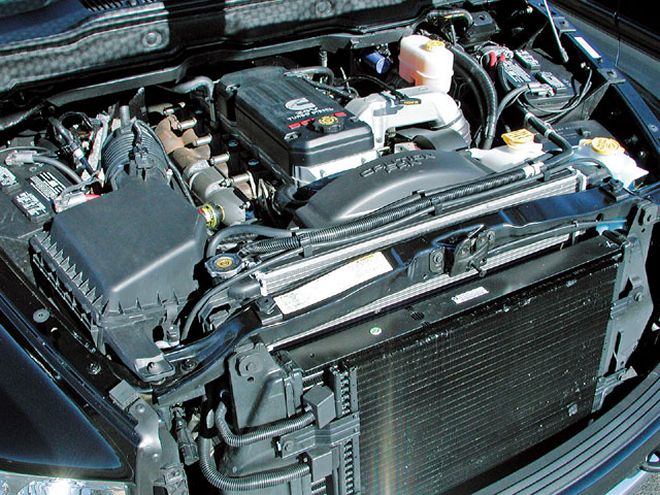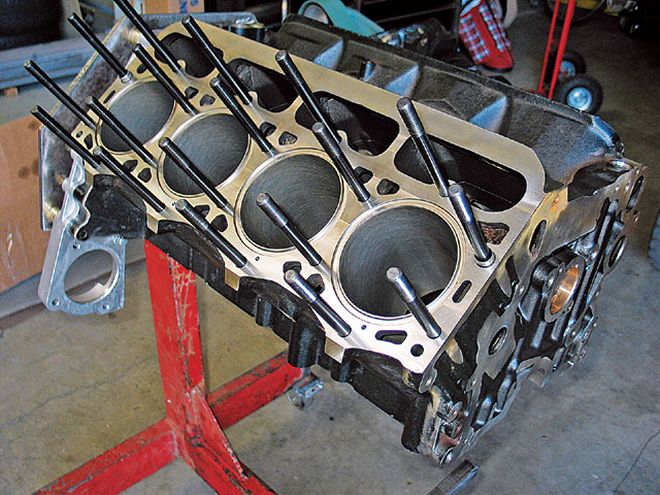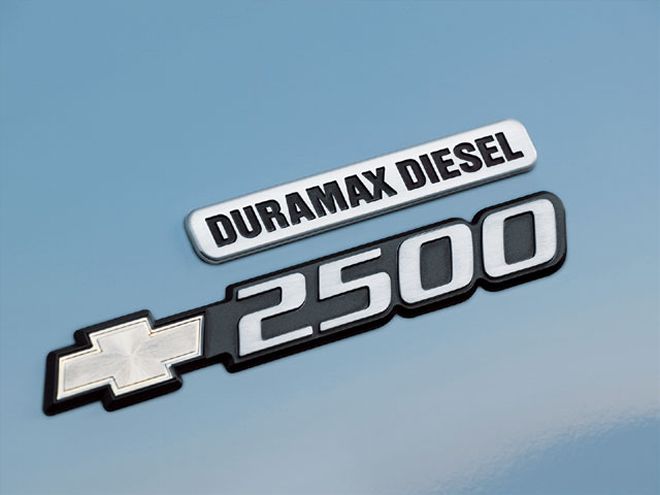
| chevy 2500 Duramax emblem
Alright, you asked for it. And now you're going to get it. Diesel Power is already the leading diesel enthusiast magazine, where readers come to learn about all things diesel-powered. Now we're going to ratchet it up a notch. Starting with this issue, we're going to field all your diesel-related tech questions. If you have a problem with your 6.9L, can't find a part number for your LLY, want to know how to make 400 lb-ft with your VW 1.8L, or just want to know what's the best transmission fluid to use in your 48RE, then this is the place for you. We'll begin this month's installment with some of the more basic questions we've already received. Where we go from here is entirely up to you. The best way to get your questions answered is to e-mail them to david.kennedy@sourceinterlink.com. If you're the type that's more comfortable with the U.S. postal service, send your questions to Top Tech, c/o Diesel Power, 6420 Wilshire Blvd., Los Angeles, CA 90048.
Now the disclaimer: Please understand that we can't return anything you send us, and that we reserve the right to edit your letter for length and content. You should also realize that we can't answer every letter we get, but we do promise to read everything you send us. Please try to limit your letter to one question, and obviously, the more information you give us about your problem and vehicle, the better our chances of solving your problem.
UPS Truck UpgradesQ: I am considering buying a used Grumman-Olson step van (UPS-style) with a diesel (generally 6.5L GM turbo). When I read Diesel Power I see all this advertising for performance parts for pickup trucks. Would they fit in the engine bay of a van? Can I get a 4- or 5-inch exhaust system for it? Upgrade the turbo? I would also want to install a conversion kit to burn used cooking oil. I would appreciate if you could point me in the right direction and/or offer some suggestions.
A: Yes and no. The injectors, pumps, and internal engine parts should interchange. Things like performance computers, air intakes, vegetable oil conversions, and intercoolers may be possible to make work. And then things like a 4-inch-diameter exhaust from BD Power (www.bd-power.com, (800) 887-5030) may only be good for donating parts to your custom setup. Readers interested in Cummins-powered UPS trucks are likely to have similar experiences but should benefit more from that engine's wide aftermarket support.
Power Stroke-Powered Cop Car?Q: Is it possible to put a diesel engine into a Ford Crown Victoria? And if so, what would the logistics of such a swap entail? What about the suspension? And the driveability? I know that this sounds crazy, but I really love diesel engines and the potential power that comes with them. But I really don't want to drive a Ford F-250 (unless you know of any other truck that Ford offers that comes with a diesel) and I really love the Crown Victoria. In my world, I would drop a Power Stroke into the engine bay of the Crown Victoria and have the Banks or Bully Dog up the power. I am really enthused about your article and the Chrysler 300C possibly coming to the United States with diesel power.... Now, if I can only convince Ford to do the same with the Vic's
A: Sure, anything is possible-even your Power Stroke-powered Crown Vic. There will be obstacles, however. The first one we see is packaging; the second is wiring. The third, and most important, is cost!
Both the 6.0L and 7.3L Power Stroke engines are significantly larger (and heavier) than the 4.6L gasoline V-8 we suspect your car has now. We're being optimistic here, but with a custom oil pan, some framerail modifications, a fabricated set of engine mounts, and a lot of firewall massaging (to clear the exhaust down tube) either Ford diesel could be made to fit. To keep things as simple as possible, we'd go with an early (pre-'99 7.3L) Power Stroke mated to a two-wheel-drive diesel truck E4OD automatic transmission. That way you won't be forced to mount an intercooler and the electronics will be somewhat simplified.
Assuming you get the engine and transmission in the car and hooked up to the cooling system, you're still going to be up against a mountain of electrical issues that will need to be resolved before you even get to fire the engine, let alone get the gauges to rear correctly. And you can forget about the factory rear axle surviving behind the diesel if you were to ever try and turn up the power.
Rest assured we'll publish any and all letters from readers who have successfully completed a similar swap, cause we know they're out there!
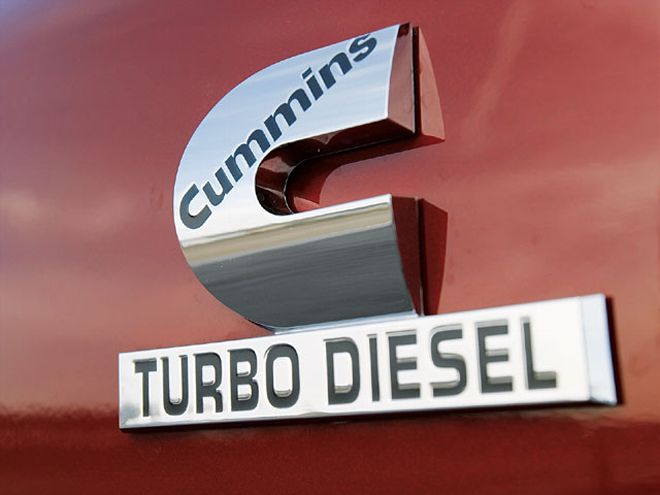
| dodge Turbo Diesel Cummins emblem
More Diesel Van QuestionsQ: Has Diesel Power done any write-ups on the Ford Diesel E350 van? I have a 2000 model and would like to know if anyone makes anything for it to make it run better than it does stock. Hope you can help me out.
A: We've done some testing with Bully Dog Technologies' Dominator system with Outlook monitor and 4-inch cat-back exhaust on a 6.0L Power Stroke E-350 van. The results were impressive: 340 hp and 680 lb-ft of torque at the rear wheels. It's important to keep in mind, though, that most performance chips are calibrated for the pickup truck applications. The van architecture is similar, but the power outputs are always lower. Our recommendation is that you call around and ask your supplier of choice if it recommends its program for use in a van. For your 7.3L application we'd recommend you give a call to TTS Power Systems (www.ttspowersystems.com, (310) 669-8101). As we know, it has done some work specifically for van applications.
Using Un-Taxed Diesel FuelQ: I look forward to reading your magazine every time I get it in the mail. I have a good question for you. We have a 2000 F-250 super duty 7.3L that stays on the farm and never goes on the road (mainly because of body damage) but the truck runs great and gets the job done. I know it would be illegal, but would off-road non-tax diesel hurt the engine in any way? Everyone tells me the only difference between on-road and off-road is the color. Is this true, or is there a difference? If so, what is the difference? And what damage could it do to our truck?
A: Currently, the only consistent differences between the two fuels is that "on-road" fuel is "clear" and has anywhere from $0.50 to $1.00 per-gallon tax added to the price. "Off-road" diesel is dyed red to signify that the fuel has not been taxed for road use and is, subsequently, illegal to use in a vehicle operated on public roads. It is unlikely that your Ford's Power Stroke engine will notice the difference at all between the two fuels, but nationwide spot-checks of diesel vehicles' fuel tanks by the Highway Patrol make this a risky proposition for motorists. Come October 15, 2006, on-road diesel fuel will have significantly lower sulfur content to work with the new diesel-engine emission systems that will be phased in for the '07 model year.
Duramax Swap in an 8.1L TruckQ: I got a pretty good deal recently on a 2001 Chevy HD crew cab shortbed 4x4 with a 6-inch lift and 35-inch BFGoodrich tires. It's got the 8.1L big-block gasoline engine, and I was wondering about swapping it out for a Duramax. I do a lot of towing and would really like to improve my mileage. The truck's got 123,000 miles on it, but it's in great shape, and I'm thinking, even with the price of the engine, the conversion would be a whole lot cheaper than a new truck. What do you think?
A: We'll give you this much: The Duramax swap you propose is probably the cheapest Duramax swap people can do. But it still may be easier and more cost-effective to sell your 8.1L pickup and buy a factory Duramax truck. Assuming that's not an option, let's look at where you should begin.
You are ahead of the game in that the front and rear axle, transfer case, frame, transmission, suspension, and sheetmetal are all shared between the Duramax and 8.1L trucks. It's still going to be our recommendation, however, that you begin your swap with a wrecked Duramax truck of the same year. That way you'll get all the little pieces that will nickel and dime you to death if you have to buy them one at a time.
The engine will bolt-in with the Duramax engine mounts, attach to your Allison transmission (with the diesel torque converter), and clear the Duramax-specific radiator, intercooler, and radiator hoses. Again, wiring will be the most difficult part, as you effectively trick your 8.1L truck into thinking it's a factory diesel-powered machine. Until the aftermarket develops a stand-alone Duramax computer and wiring harness (hint, hint!) this is really your only option.
Synthetic Diesel OilQ: I currently own a 2005 Dodge Ram 2500 and was looking into Amsoil fully synthetic products. Amsoil suggested I run its Series 3000 5W-30 synthetic motor oil. I am shocked it recommends such light oil. It also sells a 15W-40 but says I will have better benefits with 5W-30. I live in Wisconsin, where temperatures go between -30 and 90F. Could you give me any suggestions on what to run? I just subscribed to your magazine and think it's awesome.
A: Many enthusiasts make the switch to fully synthetic lubricants because they know it is the best stuff that money can buy. The advantages are, traditionally, lower mechanical wear, less friction, and better extreme-temperature properties.
It is likely that your Amsoil representative is recommending the lower viscosity oil because his test data shows that it will handle the loads and temperature cycles that conventional 15W-40 motor oil does. And Amsoil is correct in saying that you will gain the benefits of a lower-viscosity oil (quicker oiling, better fuel economy, and less hydraulic drag in the lubrication system) with the 5W-30 oil. If you look at your owner's manual, however, you'll probably find that Dodge (and Cummins) recommends 5W-30 oil be used only when you operate your truck in temperatures below 30 degrees Fahrenheit. So, here's the linchpin that we can't agree to: If you use 5W-30 motor oil (even top-quality Amsoil synthetic oil) when the engine manufacturer recommends 15W-40-and heaven forbid you have a lubrication problem-you could find yourself picking up the tab for a repair that may have otherwise been covered under warranty. Our recommendation: Run the 5W-30 Series 3000 synthetic oil as soon as it starts to get below freezing outside, and run the 15W-40 Amsoil in the summer when it is (relatively) hot out. That way you'll get the benefits of the synthetic year round, you're warranty will stay intact, and you won't have to wonder/worry if you're doing the right thing.
Real Power FiguresQ: Hey! First off, great magazine! I've read them all, and when I'm done with them I send them to my older brother. One question I have, though, is that I've heard that different diesels (Power Stroke, Cummins, and Duramax) rate their output at different places (either the rear wheels or at the flywheel). I know that at the flywheel the output would be greater before it's reduced by the drivetrain, so I was wondering if you guys knew anything about it or what manufacturers rate at which spot. And if it does rate at different spots, what is the rear wheel torque and horsepower of all three? I was talking with a friend about how a Power Stroke rated at 560 lb-ft could pull a 5,000lb trailer to 60 mph almost 3.5 seconds faster than a Duramax rated at 590 lb-ft of torque, which is almost 2 seconds faster than a Cummins rated at 600 lb-ft with the same horsepower rating. How is this possible?
A: The truth of the matter is that all three manufacturers rate their diesel engines' output at the crankshaft. The numbers are generated based on a procedure authored by the Society of Automotive Engineers (SAE) to provide consistent comparison between makes and models. The reality is that the horsepower and torque numbers you see in ads and watch on television are somewhat "tuned" by the marketing departments that work for each truck manufacturer. That's why Diesel Power magazine spends so much time taking vehicles to what is known as a chassis dynamometer.
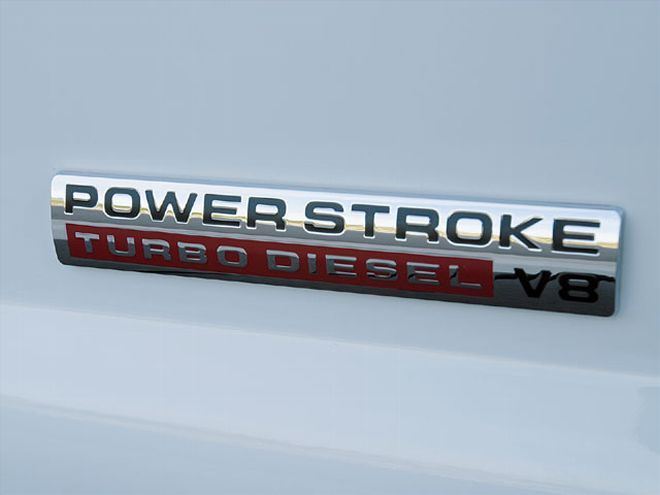
| ford Power Stroke Turbo Diesel emblem
A chassis dyno measures a vehicle's torque production at the rear wheels. The numbers are always lower than what the manufacturer rates the engine at because engine power is lost spinning the transmission, transfer case, driveshaft, axles, and wheels before it ever makes it to the dyno. In our most recent test of 2006 model-year trucks, the Dodge Cummins rated at 325 hp and 610 lb-ft of torque (at the crankshaft) actually made 289.9 hp and 530 lb-ft of torque at the rear wheels. The 6.0L Power Stroke that's rated at 325 hp and 570 lb-ft (at the crankshaft) managed 274.8 hp and 443.6 lb-ft of torque at the rear wheels in our testing. And the Duramax diesel that is rated at 360 hp and 650 lb-ft (at the crankshaft) proved to be capable of 315.7 hp and 569.5 lb-ft of torque at the rear wheels.
The rear wheel horsepower and torque numbers are very informative, but they only tell part of the story. When combined with multi- speed transmissions, the three trucks' performance gap widens even more. Again, based on our testing, the General Motors Duramax has a clear advantage over the other two engines. But the torque wars still rage on!
ATF as a Diesel Fuel Additive?Q: I have a 2000 Ford F-250 7.3L diesel. Is it a good thing to run automatic transmission fluid in the fuel tank to clean out the fuel system? My grandpa has a 2003 F-350 with the 6.0L and he is an old-school diesel mechanic. He uses ATF in all his diesel cars and trucks. He has also had many problems with his 6.0L engine, injectors being one of them. Basically, does it hurt the new motors because they are so electronic? If it does hurt them, could you please explain why?
A: Pouring automatic transmission fluid into the fuel tank with diesel fuel is a practice that's over 50 years old. The ATF burns just fine in the engine and seems to loosen and lubricate everything in the fuel system-in a positive way. We've been known to mix a bottle of ATF in with 30 gallons of diesel fuel at each fill-up to smooth out rough injectors and add a level of protection to the injection pump internals. Why does it help? We're going to have to find a chemist who's willing to go on the record to say exactly why, but we can tell you it works on mechanical injection diesels.
The one caution we have to share is that those of you with high-pressure (common rail and 6.0L Power Stroke) injection engines should avoid using ATF as an additive. It seems that at pressures near 26,000 psi the ATF can harm the injectors and pump. Again, more research is needed in this area, but we'll only recommend using ATF in 7.3L Power Strokes, '02-and-earlier Cummins engines, and 6.2 and 6.5L GM diesel engines.
Power And Fuel EconomyQ: I currently own a 2002 Excursion 4x4 with a 7.3L Power Stroke and plan on buying a 2007 Ford F-350 crew cab 4x4 with the 6.0L Power Stroke. I am not a mechanic and have limited knowledge with diesel engines. I have owned a diesel truck for the past 11 years and am a huge fan of diesel engines. I would like to upgrade both vehicles to get optimum mileage. I was looking at installing a new air filter system, exhaust, and some type of performance chip. As I said, my goal is to improve my mileage to the ultimate I can. The problem is, there is an overwhelming amount of advertisements for upgrades (just look at your magazine) and I do not know where to start.
I would like to upgrade the suspension as well-about 2-3 inches on the truck to improve ride. I will carry a pop-up camper on occasion, weighing about 2,000 to 2,800 lbs. I would really appreciate any suggestions and input you may have in regards to these matters.
A: If you're looking for mild power gains in addition to the best fuel economy you can get, start with the basics. A free-flowing 4-inch turbo back exhaust system will alleviate your engine from having to push the exhaust out of the motor. A free-flowing cold-air intake kit will also free up some power that would otherwise be wasted trying to suck air in.
Beyond that, you want to play a conservative game and go with a mild towing calibration upgrade that is designed to maximize fuel economy and performance and not harm driveability. We also recommend installing an exhaust gas temperature gauge (EGT). A high EGT means lots of fuel is being burned. A low EGT means you're maximizing fuel consumption.
Lately, we've heard claims of power and fuel economy improvements that come with a set of Extrude Honed injectors. Basically, the power and fuel economy come from better flowing injectors that don't rob as much power from the injection pump as it tries to force fuel into the combustion chamber. Stay tuned for the results of our testing.
Cummins B-Series DimensionsQ: I am considering a couple of swaps for the Cummins 5.9L. Do you know where I can get external dimensions for this engine?
A: Length: approximately 40 inchesWidth: approximately 24.9 inchesHeight: approximately 35.5 inchesWeight: approximately 1,185 lbs
Cummins 4BT 3.9L Power OutputQ: I would like to know what the torque rating is on a Cummins 4BT 3.9L diesel engine. I have been watching a few auctions on eBay, both looking for a diesel Suburban or Yukon, and possibly getting one of these four-cylinder engines for my old FJ-40. These ads on eBay only tell the horsepower, not torque. Can you help me out?
A: We've seen the naturally aspirated version rated up to 76 hp and 136 lb-ft of torque. At the high end, the turbocharged versions are capable of 150 hp and 221 lb-ft of torque.
Ideal Cummins Swap CandidateQ: First off, I want to say your magazine rocks! But I have a problem. I want to put a newer Cummins engine in my 1991 Dodge Ramcharger. I am currently looking for an '04-'06 Dodge truck that has been wrecked. Any tips on the install or any other parts of this process would be really helpful.
A: If you plan to run your current transmission, you'll want to get a Cummins engine from a manual transmission application so that the computer isn't looking for feedback from an automatic transmission that isn't there. You'll want a lot of parts from a '93 Dodge Ram diesel truck. Pieces like the intercooler, radiator, plumbing, and radiator core support. And you'll need to upgrade your front suspension to handle the extra weight. You'll also quickly find out the stock axles you have won't handle the torque, so plan on swapping in a '77-'93 Dodge Dana 60 front and Dana 70 rear axle.
Low Buck 6.2L UpgradesQ: I've been following along with the new diesel trend and like most 16-year-old kids, I can't afford a new diesel pickup, so I purchased a 1984 Chevy K20 with the 6.2L diesel engine and 4-speed manual transmission. Right now, the only performance it has is dual 3-inch exhaust pipes (without mufflers) and I love it. But I want a little more performance from it. I am looking for something small, like a cold-air intake or propane injection, just to make it run a little hotter. Can you please help me with this power problem?
A: Propane is always an option, though we know of no commercially available kits for the 6.2L. Basically, you'll be stuck retrofitting a system designed for a Power Stroke or Cummins engine. There is a new dual-snorkel cold-air system from Ram Air Box (www.ramairbox.com, (905) 549-6135). We'd add both and install an EGT gauge so you can tune-in the fueling rate without exceeding 1,200 degrees under load.
Lift Pump UpgradeQ: I have a '97 F-350 with the 7.3L Power Stroke diesel and I will be purchasing an Edge Evolution here in the very near future. I have installed a K&N intake and a 4-inch turbo-back exhaust. I have heard that if you program or put a chip in your truck that you should also upgrade fuel pumps. Is this true?
A: Even at these power levels (in the 350 hp range) your factory lift pump will be enough. When you start adding larger injectors, it'll be a different story.
 | chevy 2500 Duramax emblem
Alright, you asked for it. And now you're going to get it. Diesel Power is already the leading diesel enthusiast magazine, where readers come to learn about all things diesel-powered. Now we're going to ratchet it up a notch. Starting with this issue, we're going to field all your diesel-related tech questions. If you have a problem with your 6.9L, can't find a part number for your LLY, want to know how to make 400 lb-ft with your VW 1.8L, or just want to know what's the best transmission fluid to use in your 48RE, then this is the place for you. We'll begin this month's installment with some of the more basic questions we've already received. Where we go from here is entirely up to you. The best way to get your questions answered is to e-mail them to david.kennedy@sourceinterlink.com. If you're the type that's more comfortable with the U.S. postal service, send your questions to Top Tech, c/o Diesel Power, 6420 Wilshire Blvd., Los Angeles, CA 90048.
Now the disclaimer: Please understand that we can't return anything you send us, and that we reserve the right to edit your letter for length and content. You should also realize that we can't answer every letter we get, but we do promise to read everything you send us. Please try to limit your letter to one question, and obviously, the more information you give us about your problem and vehicle, the better our chances of solving your problem.
UPS Truck Upgrades
| chevy 2500 Duramax emblem
Alright, you asked for it. And now you're going to get it. Diesel Power is already the leading diesel enthusiast magazine, where readers come to learn about all things diesel-powered. Now we're going to ratchet it up a notch. Starting with this issue, we're going to field all your diesel-related tech questions. If you have a problem with your 6.9L, can't find a part number for your LLY, want to know how to make 400 lb-ft with your VW 1.8L, or just want to know what's the best transmission fluid to use in your 48RE, then this is the place for you. We'll begin this month's installment with some of the more basic questions we've already received. Where we go from here is entirely up to you. The best way to get your questions answered is to e-mail them to david.kennedy@sourceinterlink.com. If you're the type that's more comfortable with the U.S. postal service, send your questions to Top Tech, c/o Diesel Power, 6420 Wilshire Blvd., Los Angeles, CA 90048.
Now the disclaimer: Please understand that we can't return anything you send us, and that we reserve the right to edit your letter for length and content. You should also realize that we can't answer every letter we get, but we do promise to read everything you send us. Please try to limit your letter to one question, and obviously, the more information you give us about your problem and vehicle, the better our chances of solving your problem.
UPS Truck Upgrades | dodge Turbo Diesel Cummins emblem
More Diesel Van Questions
| dodge Turbo Diesel Cummins emblem
More Diesel Van Questions | ford Power Stroke Turbo Diesel emblem
A chassis dyno measures a vehicle's torque production at the rear wheels. The numbers are always lower than what the manufacturer rates the engine at because engine power is lost spinning the transmission, transfer case, driveshaft, axles, and wheels before it ever makes it to the dyno. In our most recent test of 2006 model-year trucks, the Dodge Cummins rated at 325 hp and 610 lb-ft of torque (at the crankshaft) actually made 289.9 hp and 530 lb-ft of torque at the rear wheels. The 6.0L Power Stroke that's rated at 325 hp and 570 lb-ft (at the crankshaft) managed 274.8 hp and 443.6 lb-ft of torque at the rear wheels in our testing. And the Duramax diesel that is rated at 360 hp and 650 lb-ft (at the crankshaft) proved to be capable of 315.7 hp and 569.5 lb-ft of torque at the rear wheels.
The rear wheel horsepower and torque numbers are very informative, but they only tell part of the story. When combined with multi- speed transmissions, the three trucks' performance gap widens even more. Again, based on our testing, the General Motors Duramax has a clear advantage over the other two engines. But the torque wars still rage on!
ATF as a Diesel Fuel Additive?
| ford Power Stroke Turbo Diesel emblem
A chassis dyno measures a vehicle's torque production at the rear wheels. The numbers are always lower than what the manufacturer rates the engine at because engine power is lost spinning the transmission, transfer case, driveshaft, axles, and wheels before it ever makes it to the dyno. In our most recent test of 2006 model-year trucks, the Dodge Cummins rated at 325 hp and 610 lb-ft of torque (at the crankshaft) actually made 289.9 hp and 530 lb-ft of torque at the rear wheels. The 6.0L Power Stroke that's rated at 325 hp and 570 lb-ft (at the crankshaft) managed 274.8 hp and 443.6 lb-ft of torque at the rear wheels in our testing. And the Duramax diesel that is rated at 360 hp and 650 lb-ft (at the crankshaft) proved to be capable of 315.7 hp and 569.5 lb-ft of torque at the rear wheels.
The rear wheel horsepower and torque numbers are very informative, but they only tell part of the story. When combined with multi- speed transmissions, the three trucks' performance gap widens even more. Again, based on our testing, the General Motors Duramax has a clear advantage over the other two engines. But the torque wars still rage on!
ATF as a Diesel Fuel Additive?